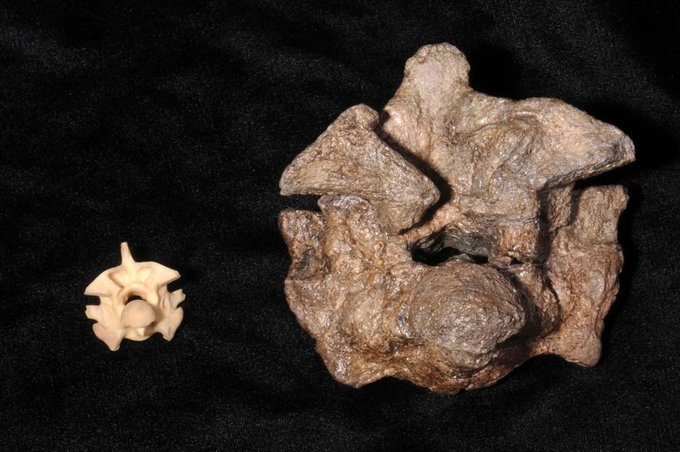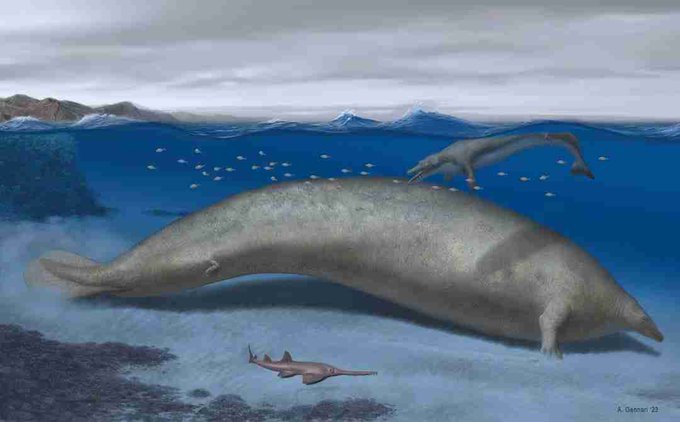What’s the biggest animal you’ve ever seen in real life? An elephant maybe? A giraffe? Perhaps you’ve actually seen a blue whale! They’re all pretty huge, but amazingly, these aren’t the biggest animals to have ever existed. In fact, they’re not even the biggest of their kind! Let's explore the biggest animals that have ever walked the earth, and what they were able to do!
Arthropleura: Largest Terrestrial Arthropod
For most people, the sight of a millipede crawling along the floor is enough to send chills down their spine. And if you’re one of those people, you better thank god you weren’t around 300 million years ago. Back then, during the Carboniferous period, a critter known as the Arthropleura lived on our planet.

This enormous creature goes down as the largest ever terrestrial arthropod. How large? Based on fossils found in Northumberland, England, it’s assumed these animals could grow about 8.2 feet long, that’s over 2 feet longer than your average human! Want to know something that makes them worse? When threatened, it’s been suggested that these big bugs could lift up their upper body, like a cobra. However paleontologists haven’t been able to confirm this from fossil findings alone. Even so, can you imagine this thing rearing up and towering over you? On top of that, the Arthropleura’s fossil indicates it had a body mass of some 110 pounds! That makes it about the same weight as an average 14-year old human child! For reference, the largest terrestrial arthropod alive today is the coconut crab. While they look horrifyingly huge in their own right, they’re just 40% as long and less than 10% as heavy as the Arthropleura! The question is, what caused these massive millipedes to get so big? During the Carboniferous period, oxygen levels in the atmosphere were greater than 30%, around 10% higher than the levels today. Thanks to the elevated oxygen, arthropods, which take on oxygen far less efficiently then mammals, were able to bulk up more than they’d be able to nowadays.

Epicyon Haydeni: Largest Canid
Epicyon Haydeni was a prehistoric canine that lived during the late Miocene period between 12 and 6 million years ago. These guys go down as the largest canines ever to exist. They were about the size of a grizzly bear, standing a horrifying 3 to 4 ft at the shoulder and up to 8 ft long, this was the largest canid ever known!

AI-Generated via Midjourney
Epicyon Haydeni were also pretty bulky, usually weighing in around 250 lbs, which is around the equivalent weight of 70 chihuahuas! One specimen on the bulkier side even exceeded that, with the humerus from one fossil specimen indicating it must’ve been at least 370 lbs. Incredibly, that also puts it at the weight of a small grizzly bear too! But size wasn’t the only thing these chunky canines shared with bears. They belonged to the Borophaginae subfamily of canines, which translates to bone-crushing dogs. Unsurprisingly, Epicyon haydeni were equipped with extremely powerful jaws, robust molars and incisive canines to take down pretty much anything that crossed its path. Fossils of their giant teeth and mandibles which are some 6 inches long reveal they were specialized to a hyper carnivorous, bone crushing diet, like hyenas, which, curiously, are not canids. If these guys were still kicking about, they’d make the best guard dogs ever!
Elephant Bird: Biggest Bird
Much like canines, birds also come in all shapes and sizes. From teeny-tiny 2 ¼ inch bee hummingbirds, to gigantic ostriches that stretch up to 9 feet tall and weigh in at up to some 300 lbs! But while ostriches may top the scale for largest living bird, they’re no match for one type of extinct feathered fowl!
Known aptly as
Elephant birds, these flightless giants strutted around the islands of Madagascar until they died out around 1,000 years ago. And they weren’t just big. For perspective, this is one of their eggs!
These are the largest bird eggs ever found. Each one was in excess of 12 inches long, and weighed up to a back-breaking 22 lbs, with a volume 150 times greater than a chicken’s egg. In modern times, ostriches lay the largest eggs of any bird, yet they’re only a seventh of the weight and half the height of the eggs of an elephant bird! But enough egg talk! How big were the birds themselves? DNA from skeletal remains indicate that these flightless giants stood 10 feet tall, making them roughly a foot taller than the average ostrich. With the largest bird of the species, Aepyornis maximus, clocking in at an ungodly 1,100 pound mass, they were 4 times heavier than ostriches.
Parapuzosia Seppenradensis: Largest Ammonite
For our next colossal critter, we’ve got to take a dive down into the depths of the ocean. It’s here where you’ll find cephalopods, the group that includes marine mollusks like the squid, octopus and cuttlefish. The title of the longest cephalopod alive today goes to the giant squid.
In some cases, they grow to over 42 feet. Granted, most of this length is in its tentacles, with the body span being closer to 8 feet. Length isn’t the only sizeable thing about these squid though, they’ve also got the largest eyes in the animal kingdom. At up to 10 inches in diameter, their peepers are about the same size as a human’s head! Measuring in 33-feet long, Colossal Squid are, ironically, slightly shorter than their Giant cousins. Despite that, their chunkier body makes them the heaviest living cephalopod, weighing in at a hefty 1,100 pounds, close to double the weight of a large giant squid. Surprising as it may seem, neither the colossal or giant squid are the world’s heaviest cephalopod, though. Instead, that accolade goes to the Parapuzosia seppenradensis!
These ammonites, or shelled cephalopods, lived way back during the Late Cretaceous period between 100 and 66 million years ago. The largest fossil shell of this astonishing ammonite was close to 6 feet in diameter. However, this was an incomplete specimen, with estimates that a whole shell had a 11-foot wide diameter, meaning based just their shells, these chunky cephalopods would dwarf us humans!
Even more impressively, the Parapuzosia seppenradensis’ shell alone may have weighed over 1,500 pounds. That’s almost a third more than the colossal squid, and that’s just this thing’s shell! The total weight of these beasts may have exceeded 3,200 pounds, or 1.6 tons! But how come they got so big? Well,
one study assessed historical ammonite finds, and argued that pressures from predators at the time forced these ammonites to evolve to be bigger, and therefore harder to hunt, though their findings were inconclusive. It’s a miracle these giants didn’t just sink to the seafloor!
Gigantopithecus Blacki: Largest Primate
Eastern lowland gorillas are the largest, and most imposing, living primates in the world. Full-grown males stand 5 ½ feet upright, while their massive muscular bodies weigh as much as 485 pounds. Intimidating as these gorillas look, there once existed a primate that would’ve made even them nervous.
Only tooth and jawbone remains of the
Gigantopithecus blacki have been discovered to date, but they’re so large that paleontologists estimate that this prodigious primate would’ve towered up to 10-feet tall, and weighed a staggering 1,200 pounds! That would have made them nature’s basketball hoops; basketball hoops that were as heavy as a cow!
Sadly though, the Gigantopithecus blacki’s formidable frame is what led to its downfall. While it was likely a herbivore, due to its size it would’ve depended on a large amount of food, like fruits, leaves and forest plants. However, around 100,000 years ago, global warming meant more and more forested area turned into savanna landscapes, depleting the Gigantopithecus blacki’s food sources.
Titanoboa: Largest Snake
Studies into phobias have loosely established that around half of all adults feel anxious about snakes, with 2 to 3% of them meeting the criteria of a snake phobia. And, to be fair who can blame them, when there are serpents like the 30-foot long and 550-pound green anaconda out there. However, things could be a whole lot worse for those that get the snake shakes!
Back around 60 million years ago, during the Paleocene period, the world was home to the biggest species of snake ever discovered: the
Titanoboa! From the name, you might be thinking of a snake that can rear itself up above the tree line, or that could take up the width of an entire road, and you’re not far off.

Based on fossils of a gigantic vertebrae discovered in Colombia, which you can see compared to a regular anaconda vertebrae in the image below, archeologists believe these sizeable serpents could grow to a hair-raising 42 feet, over 7 times the length of an average human, and, if it reared up just half of its body, it would tower of you at the height of a 2-story building! Titanoboa are also estimated to have weighed up to 2,540 lbs, which is as heavy as a small car, and almost 5 times as heavy as a green anaconda! The good news? They weren’t venomous. The bad news? They were constrictors. That’s right, these 42-foot long beasts got their meals by coiling around, crushing and asphyxiating whatever prey they could get their bodies on. Thank god these aren’t still kicking around,could you imagine if one of these snakes slithered through a town? They’d have to call the army in! These guys have serpently cemented their place as one of the world’s largest animals!
Arctotherium Angustidens: Biggest Bear
From behind glass, or on a screen, polar bears look pretty cute! Up close though, it’s a more terrifying story. These Arctic-based animals can weigh more than 1,300 pounds, 5 ft at the shoulder, and reach 10-feet in length, making them not only the largest bear, but the largest living land carnivore too. Yet they aren’t the biggest bears to ever walk the planet; they’re not even close.
Going back 700,000 years, the
Arctotherium Angustidens was endemic to South America, and takes the title for biggest bear ever. For perspective, let's compare the humerus specimen, which is the top bone of the front appendage. In the image below, we have the humerus of a spectacled bear (about 160 lbs) and that of an American black bear (around 460 lbs).
Meanwhile, the gargantuan humerus in the image below is from Arctotherium Angustidens, which paleontologists have concluded means the bear was somewhere between 2070 lbs, and 4500 lbs. Even at the smallest, that’s still about a third more than the biggest polar bear!
When they stood on their hind legs, their fossilized remains suggest they would’ve reached a neck-breaking height of 14 feet! Even the paws of the Arctotherium Angustidens were huge. At a length of 15 inches they’re more than double the size of a human hand. Unfortunately for these big bears, their stupendous size also led to their downfall. It’s theorized smaller and faster predators outnumbered and excelled against them, limiting their food source until they eventually died out 700,000 years ago.
Sarcosuchus Imperator: Super Croc
In Niger, West Africa, there was once a species of crocodilian that didn’t just rule the food chain here, it dominated it. Modern day Saltwater crocodiles aren't nothing to mess with. They can reach some 23 ft in length, and weigh up to 2,650 lbs, the largest and heaviest living reptiles in the world, which makes encounter with them more terrifying.
Although, that’s nothing compared to what was once known as the
Sarcosuchus Imperator, which lived during the Early Cretaceous Period around 112 million years ago. Based on skull and vertebrae fossils, paleontologists estimate these crocs grew up to 40-feet in length.
While in terms of weight, they’re likely to have packed on close to 9 tons! That makes this Super Croc twice the length, and nearly 8 times as heavy as Lolong, the 18 ft long and 2,370 lb beast that was the largest crocodile ever held in captivity. If that wasn’t fearsome enough, these abnormal amphibians had super-long snouts too, filled with no less than 132 conical teeth which were up to 6-inches long!
Thanks to their bulky build, and the fact that its teeth didn’t interlock indicates to paleontologists that the Sarcosuchus imperator had the ability to ambush and prey upon anything that entered the water, whether it was giant fish, or even dinosaurs.
Palaeoloxodon Namadicus: Largest Elephant
It probably won’t come as a surprise that the largest living land animal is the elephant. To be specific, the African elephant, with bulls reaching a shoulder height of 13 feet and a whopping weight of 12 tons! But somewhere between 2.5 million and 11,700 years ago during the Pleistocene period, it turns out there was an even more enormous elephant on the scene.
Based on the discovery of a partial femur estimated to be some 6 ft 2 inches long, paleontologists have estimated that an ancient elephant known as
Palaeoloxodon Namadicus, was an imposing 17-feet tall at the shoulder, meaning they’d tower over any modern-day elephant. That’d also make them taller than a T-Rex and human combined!
On top of that, these bulky beasts weighed in at a whopping 24 tons, making them well over twice as heavy as an African elephant. One look at the skull of these guys tells you just how gigantic they really were, and at a staggering 12-feet long, their straight tusks were twice the length of an average African elephant tusk.
In fact, one tusk alone is estimated to have had a mass of 260 pounds, meaning it’s more than 60 pounds heavier than the average American adult human! All that crowns these ancient elephants as the largest land mammals to ever walk the Earth.
Leedsichthys: Largest Fish
Back in 1886 on a farm in Peterborough, England, paleontologists discovered what they thought were the back plates of a stegosaurus. Except, the more they uncovered, the more unsure they became of what this creature actually was! Turns out, it wasn’t a stegosaurus, or even a dinosaur, but the impossibly gigantic bones of the Leedsichthys fish!

Crazy as that sounds, it was an easy mistake to make. Out of all bony fish, which are fish that have skeletons made up of bone tissue unlike the cartilage most have, the Leedsichthys is the largest. It’s been claimed this freaky fish, that swam the world’s seas 165 million years ago, stretched back an astonishing 55 feet, making this freakish fish larger than a school bus, and close to 10 times the size of the average human! Thanks to their gigantic size, Leedsichthys would’ve also set back the scales, weighing in at around 50 tons! Today, the largest living bony fish is the formidable floating blob, known as the ocean sunfish. These things far exceed humans when it comes to size. Yet ocean sunfish are only around 10% as long as the Leedsichthys, and, even at some 5000 lbs, are less than a 20th of their weight!
Megalodon: Largest Shark
We’re actually staying underwater for now, because this next colossal critter is so sizeable it’d have made even the Leedsichthys nervous! Meet the Megalodon.
While
The Meg was a fictitious action film about a gigantic shark, the Megalodon itself was a real shark! In fact, it was the largest shark to have ever existed, and one of the largest fish in the world, which terrorized the oceans during the Miocene and Pliocene period, approximately 20 to 3.6 million years ago. Exactly how big it could grow is up to debate, with all estimates based on tooth size, the largest verified specimen of which is a colossal 7.48 inches long. But why teeth? Because sharks don’t have bones; their skeletons are made of cartilage, which doesn’t fossilize well.
Smaller estimates from the Natural History Museum
put it at just 50 ft, whereas some researchers claim it could reach lengths as big as 82 ft! At the largest estimate, even the average whale shark, the largest living cartilaginous fish, is no match for old Meg, reaching just half their length.
Unfortunately for anything that shared the ocean with these terrors, the Megalodon’s massive maws held some 276 of these 7 inch razor-sharp teeth, giving it a estimated maximum bite force of some 182,000 newtons. For contrast, a humans maximum bite force is around 1,317.
Titanosaur Patagotitan: Largest Dinosaur
Dinosaurs are known as the largest group of land animals that ever walked the Earth, but the herbivorous Sauropod subgroup was the biggest of them all. In fact, the biggest Sauropods were dubbed Titanosaurs, which has to be the coolest name ever. With immensely long necks and thick, squat limbs, they were well-adapted to carry their huge frames and an obscene amount of weight, but how much exactly?
Back in 1987, the biggest ever found was the Argentinosaurus, a dino from some 90 million years ago in the Late Cretaceous period. Very few bone fragments remained, and from these limited specimens, paleontologists estimated the size of this thing was some 115 to 120 ft long, and that it could have weighed in at an ungodly 77 tons, roughly the same as 12 African elephants, though this estimation was very rough.
This was a huge discovery, literally, but then in 2014,
something even bigger was found; the remains of a Patagotitan, a giant from 101 million years ago, during the Early Cretaceous period. This big beast’s femur was over 8 ft long, that is just the top of the leg bone, and it’s taller than an average human!
From this, paleontologists estimated it could have measured in at a gargantuan 123 ft long, weighing in at 63 tons! That’s as long as 20 people laid down end to end, and heavier than 9 African elephants! So, the biggest was the Patagotitan, but the heaviest is the Argentinosaurus; at least, for now. Who knows, we might dig up something even bigger in the next few years!
Perecetus: Heaviest Whale
There aren’t many animals out there that can trump the Titanosaurs for size. Sperm whales, which can make ships look teeny-tiny, do come close, measuring up to 60-feet long and able to weigh more than 80 tons! But that’s still not bigger than the Titanosaurs.
But the same can’t be said for another modern-day ocean dweller, however: the blue whale, widely seen as the largest animal ever to exist on Earth. Surprisingly though, in terms of length they come up short on both Titanosaurs, with individuals measuring from 80 to 100 feet long. They may not have the length, but the biggest blue whale ever found clocked in at 210 tons, which is almost triple the weight of the Argentinosaurus!
But, amazingly, there once existed another whale that may’ve been even larger! Back in the Eocene period, around 39 million years ago, Perucetus inhabited the world’s oceans.
With a length between 55 and 65 feet it was very large, but was stunted compared to the blue whale. Despite that, paleontologists estimated this beast weighed up to 370 tons! For context, if this ancient whale did weigh 370 tons, it’d be more than 3 times as heavy as a blue whale! Imagine the fear of having one of these ballooned behemoths swimming under your ship! But why do researchers think it was so big? When the
fossilized vertebrae of this beast were discovered, they weighed in at over 220 lbs each. It’s believed that in spite of the Perucetus’ shorter length, their skeleton would’ve weighed twice that of a blue whale’s, with a mass between 5.8 and 8.3 tons! That’s because typical bones are full of tiny holes, making them lighter. However, the bones of Perucetus were solid throughout. In fact, they’re so sturdy it’d be impossible to drive a nail into one with a hammer.
So it’s skeleton was incredibly dense, like that of a manatee. From this, researchers have theorized that the heavy bones helped keep their bodies submerged as they fed, where the remainder of their body mass was made up by a tremendous amount of fat and muscle to keep them buoyant!
The Bloop: Largest Sea Monster Ever?
But gigantic as the blue whale and Perucetus are, they’ve got nothing on what some researchers believe is the largest animal to ever exist. To explain, we’ve got to go back to 1997. Back then, researchers for the National Oceanic and Atmospheric Administration, or NOAA, were listening for volcanic activity in the southern Pacific. To do this, they placed underwater microphones across the ocean. While they didn’t pick up any volcanic activity, the scientists did hear a sound that shocked them to their core. Have a listen!
The Bloop. by Jun Tooper It may not sound like much, but the noise was so loud, that microphones 2,000 miles apart were able to pick it up. Chillingly, NOAA’s Christopher Fox noted that the sound, nicknamed the Bloop, contained a rapid variation in frequency, similar to the sounds made by marine animals. Blue whales, for example, make a similar sound that can be heard up to 1,000 miles away, with their calls reaching 188 decibels, louder than a roaring jet engine! Considering the Bloop’s call was heard 2,000 miles away, you’d assume that it’s got to be way bigger than a blue whale. It may be hard to imagine a marine monster lurking at the bottom of the blue, but the deep oceans are still around 95% unexplored by humans. So who knows what’s truly down there?Tamer estimations theorize that if the Bloop does exist, it would be 250 feet long, triple the size of some blue whales, almost big enough to prey on them! While some go as far as saying any creature that loud has to be around 700 feet long! That’s 6 times longer than a Titanosaur, 7 times longer than a blue whale, and 50 times longer than a great white!

But there are some major doubts over its existence. Today, most respectable scientists believe that the Bloop noise was actually the sound of an icequake. This is a common occurrence in the Southern Ocean that’s caused by the cracking and melting of sea ice off glaciers into the ocean. As well as that, the infamous Bloop sound is typically played back at 16 times normal speed, giving it the effect of an animal vocalization. In real-time, the sound is more similar to that of an icequake.
The Bloop | Normal and 16x Speed (HD) by AndrewJay's Investigations of the Unknown So chances are the 700-foot Bloop doesn’t exist. So, there is no supersized oceanic beast lurking in the dark depths of the Pacific that we know of. If you were amazed at the largest creatures to ever exist on Earth, you might want to read about animals that were
scarier than dinosaurs. Thanks for reading!











































